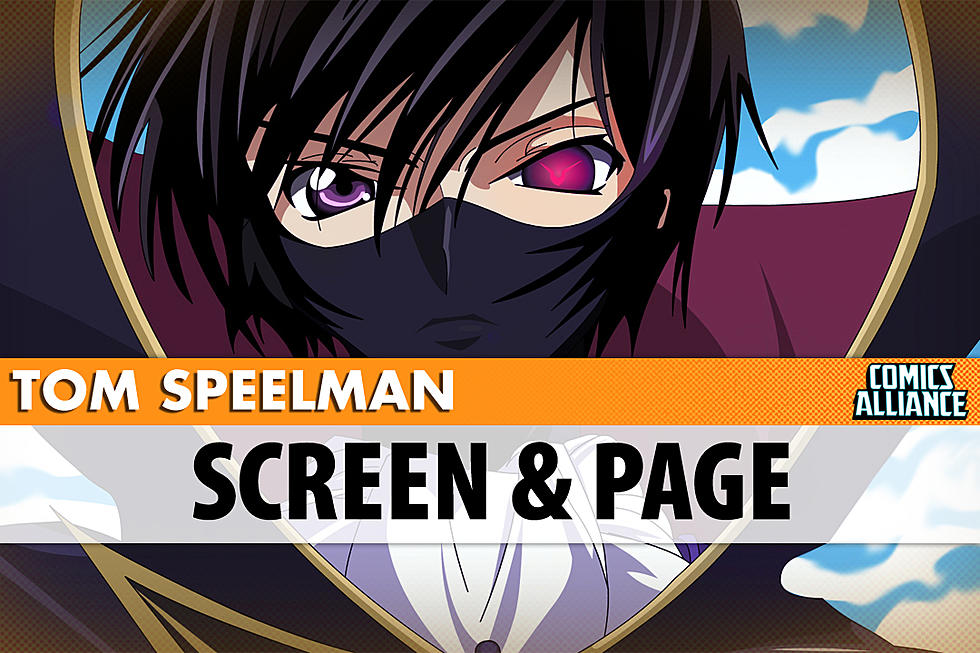
Screen & Page: Of Vespa Girls & Coming Of Age In ‘FLCL’
Most anime is adapted from manga, often produced by the manga publisher to raise awareness and selling it overseas. But what about the anime shows or film that go the other way, adapted from the screen to the page? How do those works hold up, and what changes or stays the same? That’s what Screen & Page aims to explore.
This week, we're looking at an immortal tale of girls on Vespas, vintage bass guitars, and robots coming out of a kid's head. It's FLCL!
THE ANIME
FLCL --- written by Yoji Enokido, directed by Kazuya Tsurumaki, and animated by legendary studios Gainax and Production I.G. --- is easy to summarize but hard to explain. When your show's director is quoted at length as saying, "difficulty in comprehension should not be an important factor," you're in for a wild ride.
The plot centers on surly 12-year-old Naota Nandaba, who despises his town of Mabase because "nothing ever happens here." Stuck with a weirdo, zine-writing father and abandoned by his older brother for a Stateside baseball career, Naota spends his days coolly dismissive towards all, and in some sort of physical relationship with his brother's ex-girlfriend, truant high schooler Mamimi.
This all changes when pink-haired madwoman Haruko Haruhara rides up on a yellow Vespa and runs Naota over. In short order, a bump appears on his head, Haruko becomes the Nandaba family's maid, and a big robot pops out of Naota's skull. And that's all in the first episode.
What's remarkable about FLCL (pronounced "fooly cooly," a phrase that's never defined) is that it sketches a complete world so fast, then slowly fleshes itself out over jut six episodes. But above that world-building, and a core story about the confusing darkness of adolescence, is a three-story house built out of surrealism, abstraction, and wacky comedy.
While the show can be marathoned faster than the extended edition of The Return of the King, you're not going to pick everything up the first time. This series rewards repeated viewing and analysis. On my third time watching it, I picked up on just how nasty Naota is to everyone else, in the way that only twelve-year old boys can be. Forget all those thinkpieces about Neon Genesis Evangelion that you breathlessly read on anime forums way back when; FLCL is the Gainax production worth parsing through. (Evangelion is namechecked at one point, along with Lupin III creator Monkey Punch, Gundam, and a whole lot else.)
This doesn't really feel like any other anime, and that's with good reason. For one thing, while it aired on Adult Swim here, it was originally released straight-to-DVD in Japan (or as an "original video animation," if you wanna get technical about it). While anime on television is usually finished at the last possible second and rushed to air with any number of errors that are fixed for the home video release, FLCL going right to DVD allowed Gainax and I.G. to take as much time as they wanted. This results in some truly spectacular action sequences (including a really cool first-person POV bit) and some really funny scenes drawn as explosive manga pages.
For another, this series is deliberately constructed, both visually and story-wise, after music videos. That's off-kilter enough, but FLCL does itself one better by having a soundtrack largely composed of songs by famed Japanese alt-rock band The Pillows. The songs --- particularly the series' theme, "Ride On Shooting Star" --- are punchy, lyrical and driving. Much like the show itself. The music gives the show a huge dose of rock & roll energy that makes it stand out (along with a star-making turn by Kari Whalgren as Haruko in the English dub).
It's particularly prudent to revisit this show right now, as Adult Swim recently announced the production of two new seasons totaling twelve episodes, to air in late 2017 or early 2018 on the channel's Toonami block. At just six episodes --- available on Hulu, Funimation, iTunes and DVD & Blu-Ray --- catching up is not a huge investment. And it's like no other anime --- no other TV show --- you've ever seen.
THE MANGA
While many of the manga adaptations we'll cover on Screen & Page will tend to stick pretty closely to their source material, that's definitely not the case with Hajime Ueda's FLCL manga.
Serialized in the now-defunct Monthly Magazine Z, and originally published in the US by Tokyopop, FLCL was retranslated and published in a remastered omnibus edition by Dark Horse's manga division in 2012. Like all of DH Manga's omnibus releases, it's a tight, hefty read. But honestly, that's probably the best way to read it.
As an anime, FLCL has a distinct look. But it's still grounded in basic anime aesthetics so you don't get too confused. By contrast, Ueda --- who was given free reign by the FLCL staff --- ignores traditional manga design in favor of something simpler.
So simple, in fact, that the finished product looks and reads like early Mirage Comics and the work of Jhonen Vasquez rather than, say, Fairy Tail. On the one hand, it's nice to be reminded of the stylistic depth and breadth manga can have. On the other, the really tiny figures and slightly off panel structure can occasionally get really confusing and hard to read.
Still, like its progenitor, the FLCL manga has under its unique look a very dark story. In fact, it's much darker. While the anime at one point has Naota hitting his dad with a baseball bat out of jealousy at him apparently sleeping with Haruko, it turns out to be a robot. Ueda goes one step further and has Naota straight up murder him.
There's also a lot more delving into characters' sexual psyches and emotional states, not only for Naota, but for his dad, grandpa, Mamimi --- who comes across as damaged in the show, but not much beyond that --- and even Haruko, who's less enigmatic here, to good effect.
Ueda also delves deeper into the show's sci-fi side, explaining just exactly what N.O. is --- the stuff that causes Naota to spout robots from his head --- and more about the alien war Haruko is supposedly fighting in. The manga's coda is also much more bittersweet, suggesting that Naota is actually becoming the grown-up he wants to be.
While it's a bit tough to read even for devoted fans of alternative comics, FLCL is still worth reading. If nothing else, you get exposed to Ueda's wholly unique art style and a harder-edged take on a whimsical plot. It's not deconstructionist ala Miracleman. It's forensic, breaking apart the source material's components and rebuilding and recasting them in a new, utterly compelling way.
FLCL is available streaming on Hulu & Funimation and widely available on Blu-Ray, DVD & digital. The FLCL manga is available in print from a variety of retailers and your local library.
More From ComicsAlliance

![Screen & Page: Meet Heaven’s Worst Angels In ‘Panty & Stocking With Garterbelt'[Love & Sex Week]](http://townsquare.media/site/622/files/2017/02/ps.jpg?w=980&q=75)





![Screen & Page: Honor The Covenant With ‘Blood-C’ [Fantasy Week]](http://townsquare.media/site/622/files/2016/10/blood-c-1.jpg?w=980&q=75)

